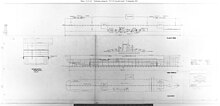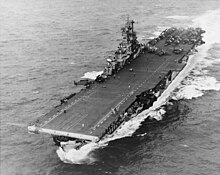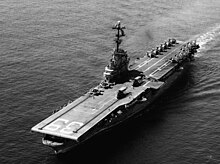Essex-class aircraft carrier
Several of the carriers were rebuilt to handle heavier and faster aircraft of the early jet age, and some served until well after the Vietnam War.A longer, wider flight deck and a deck-edge elevator (which had proven successful in the one-off USS Wasp) facilitated more efficient aviation operations, enhancing the ship's offensive and defensive air power.The larger size of the first supercarriers necessitated a deeper hull and shifted the center of gravity and center of stability lower, enabling moving the strength deck to the flight deck, thus freeing US Naval design architects to move the armor higher and remain within compliance of US Navy stability specifications without imperiling seaworthiness.The first eight hulls were originally assigned names from historic Navy ships (Essex, Bon Homme Richard, Intrepid, Kearsarge, Franklin, Hancock, Randolph, Cabot).[8] USS Shangri-La was named after a facetious remark by President Franklin Delano Roosevelt suggesting that the Doolittle Raiders flew from the fictional Himalayan kingdom setting of the novel Lost Horizon.In summary, during World War II and until its conclusion, the US Navy ordered 32 aircraft carriers of the Essex class, including the Ticonderoga subgroup, of which 26 were laid down and 24 actually commissioned.Not only were the supporting structures to the flight deck required to carry the increased weight of landing and parked aircraft, but they were to have sufficient strength to support the storing of spare fuselages and parts (50% of each operational plane type aboard, hence 33% of carried aircraft) under the flight deck and still provide adequate working space for the men using the area below.These carriers had better armor protection than their predecessors, better facilities for handling ammunition, safer and greater fueling capacity, and more effective damage control equipment.A Plan Position Indicator (PPI) display was used to keep track of ships and enabled a multi-carrier force to maintain a high-speed formation at night or in foul weather.The four-channel Very High Frequency (VHF) radio permitted channel variation in an effort to prevent enemy interception of transmissions.[1][20] However, the U.S. Navy never maintained any institutional distinction between the long-hull and short-hull members of the Essex class, and postwar refits and upgrades were applied to both groups equally.[20] Less immediately visible aspects of the March 1943 design modification included safer ventilation and aviation-fuel systems, moving the combat information center below the armored deck, the addition of a second flight-deck catapult, the elimination of the hangar deck catapult, and a third Mk 37 fire-control director; some of these changes were also made to short-bow ships nearing completion or as they returned to the yards.For example, Intrepid, one of the first to be commissioned, by the end of the war had received two H-4B flight deck catapults in place of her original single H-4A; three quad 40 mm mounts below the island to starboard, three more on the port side and one additional on both the starboard quarter and the stern; twenty-one additional 20 mm mounts; SM fighter-control radar; FD Mk 4 radar replaced with Mk 12/22; and an enlarged flag bridge.The large numbers of new ships, coupled with their larger Midway-class contemporaries, sustained the Navy's air power through the rest of the 1940s, the Korean War era, and beyond.Though the Truman administration's defense economies sent three of the active Essexes into "mothballs" in 1949, these soon came back into commission after the Korean War began.Oriskany, which had been left unfinished at the end of the war, was completed to an improved design between August 1948 and September 1950, with a much stronger (straight) flight deck and a reconfigured island.[23] An angled flight deck and enclosed hurricane bow became the distinctive features of the SCB-125 program, which was undertaken concurrently with the last three 27C conversions and later applied to all 27A and 27C ships except Lake Champlain.[23] Oriskany, the first of the modernized ships but the last angled-deck conversion, received a unique SCB-125A refit which upgraded her to 27C standard, and included steam catapults and an aluminum flight deck.[24] All initially carried attack air groups; however by 1955 seven unconverted Essexes were operating under the anti-submarine warfare carrier (CVS) designation established in August 1953.[23] As the Forrestal-class "supercarriers" entered the fleet, the eight 27A conversions were designated CVS to replace the original unconverted ships;[23] the latter began to leave active service in the late 1950s.[23] The updated units remained active until age and the growing number of supercarriers made them obsolete, from the late 1960s into the middle 1970s.Four of the modernized ships (Yorktown, Intrepid, Hornet, and Lexington) have been preserved as museums; the remainder were scrapped starting in the 1970s save Oriskany, which the Navy contemplated reactivating in the 1980s and which was eventually scuttled as an artificial reef off the Florida coast in 2006.Of the unmodernized Essexes, Boxer, Princeton, and Valley Forge were redesignated Landing Platform Helicopter (LPH) amphibious assault ships for the Marine Corps, and remained in commission with their original straight decks until about 1970.The AV-8A Harrier arrived into Marine Corps inventory too late to see regular fixed wing operations return to these ships.It was possible to launch and recover small aircraft like the OV-10 Bronco without need of catapult or arresting wires, but this was very rarely permitted on these straight-deck ships for safety reasons and to avoid interruption of helicopter operations.[30] However, their inability to support the latest aircraft constrained some of those ships to specialized roles as helicopter carriers or antisubmarine platforms.In one notable event, during the Gulf of Tonkin Incident, aircraft from Ticonderoga fired at North Vietnamese torpedo boats that had attacked a U.S.When the Cold War heated up, the Essex carriers were often involved, including Quemoy and the Matsu Islands, the Bay of Pigs Invasion, and the Cuban Missile Crisis.[37] The first steps on Earth of returning astronauts Neil Armstrong, Buzz Aldrin, and Mike Collins, are marked on her hangar deck, as part of her Apollo program exhibit.Reprisal, laid down in July 1944 at the New York Navy Yard and launched in 1945, had her construction cancelled on 12 August 1945 due to the cessation of hostilities when the ship was about half complete.











USS Philippine Sea (CVA-47)Newport News ShipbuildingFore River ShipyardBrooklyn Navy YardPhiladelphia Naval ShipyardNorfolk Naval ShipyardUnited States NavyYorktown classUSS Wasp (CV-7)Midway classUSS Yorktown (CV-10)USS Intrepid (CV-11)USS Hornet (CV-12)USS Lexington (CV-16)Aircraft carrierStandardFull loadBabcock & WilcoxboilersWestinghouseturbinesscrew propellers5-inch (127 mm) /38 caliber guns40 mm Bofors guns20 mm Oerlikon cannonaircraft carrierscapital shipMidway-classsupercarriersVietnam WarYorktownHornetLexingtonIntrepidmuseum shipsYorktown-class aircraft carriersWashington Naval TreatyLondon Naval Treatypre-war naval treaty limitsUSS Essexflight deckUSS WaspUSS FranklinUSS Bunker Hillarmoring the hangar deckhangar deckstrength deckNaval Expansion Actlead shipEnterpriseSaratogabattlecruiserNewport News Shipbuilding & DrydockTwo-Ocean Navy ActBethlehem SteelPearl HarborPhiladelphia Navy YardNorfolk Navy YardUSS Lexington (CV-2)Battle of the Coral SeaUSS Yorktown (CV-5)Battle of MidwayGuadalcanalUSS Hornet (CV-8)Battle of Santa Cruz IslandsPrincetonUSS Princeton (CVL-23)Battle of Leyte GulfTiconderogaHancockJohn Hancock life insurance companyFranklin Delano RooseveltDoolittle RaidersOriskanycatapultsBureau of ShipsPhilippine SeaSpecial Treatment SteelIndependencetask groupfast carrier task forcefightersdive bomberstorpedo bombersGrumman F6F HellcatDouglas SBD DauntlessCurtiss SB2C HelldiverGrumman TBF AvengerBunker HillVought F4U CorsairsPacific WarHigh Velocity Aircraft Rockets5 in (127 mm)proximity fuzedBofors 40 mm anti-aircraft gunsOerlikon 20 mm cannon1.1 in/75 caliber gunsSK air-searchSG surface-searchPlan Position IndicatorIdentification Friend or FoeVery High Frequency (VHF)Bon Homme RichardLong Beach Navy YardKorean Warjet-blast deflectorsoptical landing systemTruman administrationCold WarSCB-27AntietamSCB-125Lake ChamplainShangri-LaFranklinanti-submarine warfareForrestal-classValley ForgeLanding Platform Helicopteramphibious assault shipsMarine CorpsRoyal Australian NavyHMAS MelbourneBenningtonFJ-3 FuriesF2H Banshees